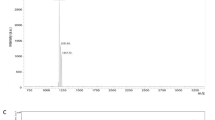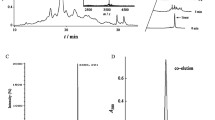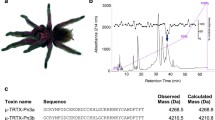Abstract
The venom of the Brazilian armed spider Phoneutria nigriventer is a rich source of biologically active peptides that have potential as analgesic drugs. In this study, we investigated the analgesic and adverse effects of peptide 3-5 (Tx3-5), purified from P. nigriventer venom, in several mouse models of pain. Tx3-5 was administered by intrathecal injection to mice selected as models of postoperative (plantar incision), neuropathic (partial sciatic nerve ligation) and cancer-related pain (inoculation with melanoma cells) in animals that were either sensitive or tolerant to morphine. Intrathecal administration of Tx3-5 (3–300 fmol/site) in mice could either prevent or reverse postoperative nociception, with a 50 % inhibitory dose (ID50) of 16.6 (3.2–87.2) fmol/site and a maximum inhibition of 87 ± 10 % at a dose of 30 fmol/site. Its effect was prevented by the selective activator of L-type calcium channel Bay-K8644 (10 μg/site). Tx3-5 (30 fmol/site) also produced a partial antinociceptive effect in a neuropathic pain model (inhibition of 67 ± 10 %). Additionally, treatment with Tx3-5 (30 fmol/site) nearly abolished cancer-related nociception with similar efficacy in both morphine-sensitive and morphine-tolerant mice (96 ± 7 and 100 % inhibition, respectively). Notably, Tx3-5 did not produce visible adverse effects at doses that produced antinociception and presented a TD50 of 1125 (893–1418) fmol/site. Finally, Tx3-5 did not alter the normal mechanical or thermal sensitivity of the animals or cause immunogenicity. Our results suggest that Tx3-5 is a strong drug candidate for the treatment of painful conditions.





Similar content being viewed by others
Abbreviations
- ANOVA:
-
Analysis of variance
- BSA:
-
Bovine serum albumin
- EDTA:
-
Ethylenediamine tetraacetic acid
- ID50 :
-
Inhibitory dose 50 %
- IL-1β:
-
Interleukin-1 beta
- i.p.:
-
Intraperitoneal
- i.pl.:
-
Intraplantar
- i.t.:
-
Intrathecal
- LPS:
-
Lipopolysaccharide
- PBS:
-
Phosphate-buffered saline
- PMSF:
-
Phenylmethylsulphonyl fluoride
- PSNL:
-
Partial sciatic nerve ligation
- s.c.:
-
Subcutaneous
- TD50 :
-
Toxic dose 50 %
- Tx3-5:
-
Peptide 3-5
- VSCC:
-
Voltage-sensitive calcium channels
References
Antkiewicz-Michaluk L, Michaluk J, Romańska IVJ (1993) Reduction of morphine dependence and potentiation of analgesia by chronic co-administration of nifedipine. Psychopharmacol (Berl) 111:457–64
Atanassoff PG, Hartmannsgruber MW, Thrasher J, Wermeling D, Longton W, Gaeta R, Singh T, Mayo M, McGuire D, Luther RR (2000) Ziconotide, a new N-type calcium channel blocker, administered intrathecally for acute postoperative pain. Reg Anesth Pain Med 25:274–278. doi:10.1053/xr.2000.5662
Ballantyne JC, Shin NS (2008) Efficacy of opioids for chronic pain: a review of the evidence. Clin J Pain 24:469–478
Le Bars D, Gozariu M, Cadden SW (2001) Animal models of nociception. Pharmacol Rev 53:597–652
Brenneis C, Coste O, Altenrath K, Angioni C, Schmidt H, Schuh CD, Zhang DD, Henke M, Weigert A, Brüne B, Rubin B, Nusing R, Scholich K, Geisslinger G (2011) Anti-inflammatory role of microsomal prostaglandin E synthase-1 in a model of neuroinflammation. J Biol Chem 286:2331–2342
Chaplan SR, Bach FW, Pogrel JW, Chung JM, Yaksh TL (1994) Quantitative assessment of tactile allodynia in the rat paw. J Neurosci Methods 53:55–63
Coderre TJ, Melzack R (1992) The role of NMDA receptor-operated calcium channels in persistent nociception after formalin-induced tissue injury. J Neurosci 12:3671–5
Corbett AD, Henderson G, Mcknight AT, Paterson SJ (2006) 75 years of opioid research: the exciting but vain quest for the Holy Grail. Br J Pharmacol 1:153–162
Cordeiro Mdo N, de Figueiredo SG, Valentim Ado C, Diniz CR, von Eickstedt VR, Gilroy J, Richardson M (1993) Purification and amino acid sequences of six TX3 type neurotoxins from the venom of the Brazilian “armed” spider Phoneutria nigriventer. Toxicon 31:35–42
Dahl JB, Kehlet H (2006) Postoperative pain and its management. In: McMahon SB, Klotzenburg M (eds) Wall and Melzack’s Textbook of pain. Elsevier Churchill Livingstone, Philadelphia, p 635–651
Dalmolin GD, Silva CR, Rigo FK, Gomes GM, Cordeiro MDN, Richardson M, Silva MAR, Prado MAM, Gomez MV, Ferreira J (2011) Antinociceptive effect of Brazilian armed spider venom toxin Tx3-3 in animal models of neuropathic pain. Pain 152:2224–2232. doi:10.1016/j.pain.2011.04.015
Dierssen M, Flórez JHM (1990) Calcium channel modulation by dihydropyridines modifies sufentanil-induced antinociception in acute and tolerant conditions. Naunyn Schmiedebergs Arch Pharmacol 342:559–65
Dixon WJ (1980) Efficient analysis of experimental observations. Annu Rev Pharmacol Toxicol 20:441–462
Dobremez E, Bouali-Benazzouz R, Fossat P, Monteils L, Dulluc J, Nagy FLM (2005) Distribution and regulation of L-type calcium channels in deep dorsal horn neurons after sciatic nerve injury in rats. Eur J Neurosci 21:3321–33
Dworkin RH, O’Connor AB, Backonja M, Farrar JT, Finnerup NB, Jensen TS, Kalso EA, Loeser JD, Miaskowski C, Nurmikko TJ, Portenoy RK, Rice AS, Stacey BR, Treede RD, Turk DC, Wallace MS (2007) Pharmacologic management of neuropathic pain: evidence-based recommendations. Pain 132:237–251
Fajardo O, Meseguer V, Belmonte CVF (2008) TRPA1 channels: novel targets of 1,4-dihydropyridines. Channels (Austin) 2:429–38
Farmer P, Frenk J, Knaul FM, Shulman LN, Alleyne G, Armstrong L, Atun R, Blayney D, Chen L, Feachem R, Gospodarowicz M, Gralow J, Gupta S, Langer A, Lob-Levyt J, Neal C, Mbewu A, Mired D, Piot P, Reddy KS, Sachs JD, Sarhan M, Seffrin JR (2010) Expansion of cancer care and control in countries of low and middle income: a call to action. Lancet 376:1186–1193. doi:10.1016/S0140-6736(10)61152-X
Filos KS, Goudas LC, Patroni OTV (1993) Analgesia with epidural nimodipine. Lancet 342:1047
Fossat P, Dobremez E, Bouali-Benazzouz R, Favereaux A, Bertrand SS, Kilk K, Léger C, Cazalets JR, Langel U, Landry M, Nagy F (2010) Knockdown of L calcium channel subtypes: differential effects in neuropathic pain. J Neurosci 30:1073–1085
Gao YJ, Cheng JK, Zeng Q, Xu ZZ, Decosterd I, Xu X, Ji RR (2009) Selective inhibition of JNK with a peptide inhibitor attenuates pain hypersensitivity and tumor growth in a mouse skin cancer pain model. Exp Neurol 219:146–55
Gomez MV, Kalapothakis E, Guatimosim C, Prado MA (2002) Phoneutria nigriventer venom: a cocktail of toxins that affect ion channels. Cell Mol Neurobiol 22:579–588. doi:10.1023/A:1021836403433
Gupta M, Singh J, Sood S, Arora B (2003) Mechanism of antinociceptive effect of nimodipine in experimental diabetic neuropathic pain. Exp Clin Pharmacol 25:49–52
Hagiwara K, Nakagawasai O, Murata A, Yamadera F, Miyoshi I, Tan-No K, Tadano T, Yanagisawa T, Iijima TMM (2003) Analgesic action of loperamide, an opioid agonist, and its blocking action on voltage-dependent Ca2+ channels. Neurosci Res 46:493–7
Hargreaves K, Dubner R, Brown F, Flores C, Joris J (1988) A new and sensitive method for measuring thermal nociception in cutaneous hyperalgesia. Pain 32:77–88
Horváth G, Brodacz BH-PU (2001) Role of calcium channels in the spinal transmission of nociceptive information from the mesentery. Pain 93:35–41
Hylden JL, Wilcox GL (1980) Intrathecal morphine in mice: a new technique. Eur J Pharmacol 67:313–316
Ishii K, Taira NYT (1985) Differential antagonism by Bay k 8644, a dihydropyridine calcium agonist, of the negative inotropic effects of nifedipine, verapamil, diltiazem and manganese ions in canine ventricular muscle. Br J Pharmacol 84:577–84
Michaluk J, Karolewicz B, Antkiewicz-Michaluk L, Vetulani J (1998) Effects of various Ca2q channel antagonists on morphine analgesia, tolerance and dependence, and on blood pressure in the rat. Eur J Pharmacol 352:189–197
King NB, Fraser V (2013) Untreated pain, narcotics regulation, and global health ideologies. PLoS Med 10:e1001411. doi:10.1371/journal.pmed.1001411
Kuner R (2010) Central mechanisms of pathological pain. Nat Med 16:1258–1266. doi:10.1038/nm.2231
Leão RM, Cruz JS, Diniz CR, Cordeiro MN, Beirão PS (2000) Inhibition of neuronal high-voltage activated calcium channels by the omega-phoneutria nigriventer Tx3-3 peptide toxin. Neuropharmacology 39:1756–67
Leão RM, Cruz JS, Diniz CR, Cordeiro MN, Beirão PLS (1997) Calcium channel blocking toxins in the venom of Phoneutria nigriventer. J Venom Anim Toxins 3:223
Loeser JD, Treede RD (2008) The Kyoto protocol of IASP basic pain terminology. Pain 137:473–477. doi:10.1016/j.pain.2008.04.025
Luvisetto S, Marinelli S, Panasiti MS, D’Amato FR, Fletcher CF, Pavone F, Pietrobon D (2006) Pain sensitivity in mice lacking the Cav2.1??1 subunit of P/Q-type Ca2+ channels. Neuroscience 142:823–832. doi:10.1016/j.neuroscience.2006.06.049
Makin MK (2001) Strong opioids for cancer pain. J R Soc Med 94:17–21
Malmberg AB, Basbaum AI (1998) Partial sciatic nerve injury in the mouse as a model of neuropathic pain: behavioral and neuroanatomical correlates. Pain 76:215–222
Malmberg AB, Yaksh TL (1994) Voltage-sensitive calcium channels in spinal nociceptive processing: blockade of N- and P-type channels inhibits formalin-induced nociception. J Neurosci 14:4882–4890
Mantyh PW, Clohisy DR, Koltzenburg M, Hunt SP (2002) Molecular mechanisms of cancer pain. Nat Rev Cancer 2:201–209
Marshall I, Weinstock M (1971) Quantitative method for assessing one symptom of the withdrawal syndrome in mice after chronic morphine administration. Nature 234:223–224
Matthews EA, Bee LA, Stephens GJ, Dickenson AH (2007) The Cav2.3 calcium channel antagonist SNX-482 reduces dorsal horn neuronal responses in a rat model of chronic neuropathic pain. Eur J Neurosci 25:3561–3569
Matthews EA, Dickenson AH (2001) Effects of spinally delivered N- and P-type voltage-dependent calcium channel antagonists on dorsal horn neuronal responses in a rat model of neuropathy. Pain 92:235–246
McGivern JG (2007) Ziconotide: a review of its pharmacology and use in the treatment of pain. Neuropsychiatr Dis Treat 3:69–85
Miranda HF, Bustamante D, Kramer V, Pelissier T, Saavedra HPC, Fernandez EPG (1992) Antinociceptive effects of Ca2+ channel blockers. Eur J Pharmacol 217:137–141
Nossaman VE, Ramadhyani U, Kadowitz PJ, Nossaman BD (2010) Advances in perioperative pain management: use of medications with dual analgesic mechanisms, tramadol and tapentadol. Anesth Clin 28:647–666
Oliveira SM, Drewes CC, Silva CR, Trevisan G, Boschen SL, Moreira CG, De Almeida CD, Da Cunha C, Ferreira J (2011) Involvement of mast cells in a mouse model of postoperative pain. Eur J Pharmacol 672:88–95. doi:10.1016/j.ejphar.2011.10.001
Oliveira SM, Silva CR, Wentz AP, Paim GR, Correa MS, Bonacorso HG, Prudente AS, Otuki MF, Ferreira J (2014) Antinociceptive effect of 3-(4-fluorophenyl)-5-trifluoromethyl-1H-1-tosylpyrazole. A Celecoxib structural analog in models of pathological pain. Pharmacol Biochem Behav 124:396–404. doi:10.1016/j.pbb.2014.07.005
Penn RD, Paice JA (2000) Adverse effects associated with the intrathecal administration of ziconotide. Pain 85:291–296. doi:10.1016/S0304-3959(99)00254-7
Pergolizzi J, Böger RH, Budd K, Dahan A, Erdine S, Hans G, Kress HG, Langford R, Likar R, Raffa RB, Sacerdote P (2008) Opioids and the management of chronic severe pain in the elderly: consensus statement of an International Expert Panel with focus on the six clinically most often used World Health Organization Step III opioids (buprenorphine, fentanyl, hydromorphone, met. Pain Pr 8:287–313
Pogatzki-Zahn EM, Zahn PK, Brennan TJ (2007) Postoperative pain—clinical implications of basic research. Best Pr Res Clin Anaesthesiol 21:3–13
Prado WA (2001) Involvement of calcium in pain and antinociception. Brazilian J Med Biol Res 34:449–461. doi:10.1590/S0100-879X2001000400003
Pud D, Cohen D, Lawental E, Eisenberg E (2006) Opioids and abnormal pain perception: new evidence from a study of chronic opioid addicts and healthy subjects. Drug Alcohol Depend 82:218–223
Quijada L, Germany A, Hernández CE (1992) Effects of calcium channel antagonists and Bay K 8644 on the analgesic response to pentazocine and U 50488H. Gen Pharmacol 23:837–4
Richardson M, Pimenta AM, Bemquerer MP, Santoro MM, Beirao PS, Lima ME, Figueiredo SG, Bloch C Jr, Vasconcelos EA, Campos FA, Gomes PC, Cordeiro MN (2006) Comparison of the partial proteomes of the venoms of Brazilian spiders of the genus Phoneutria. Comp Biochem Physiol - C Toxicol Pharmacol 142:173–187. doi:10.1016/j.cbpc.2005.09.010
Rigo FK, Dalmolin GD, Trevisan G, Tonello R, Silva MA, Rossato MF, Klafke JZ, Cordeiro MDN, Castro Junior CJ, Montijo D, Gomez MV, Ferreira J (2013) Effect of ω-conotoxin MVIIA and Phα1β on paclitaxel-induced acute and chronic pain. Pharmacol Biochem Behav 114-115:16–22. doi:10.1016/j.pbb.2013.10.014
Rigo FK, Trevisan G, Rosa F, Dalmolin GD, Otuki MF, Cueto AP, de Castro Junior CJ, Romano-Silva MA, Cordeiro MDN, Richardson M, Ferreira J, Gomez MV (2013) Spider peptide Phα1β induces analgesic effect in a model of cancer pain. Cancer Sci 104:1226–1230. doi:10.1111/cas.12209
Rosa F, Trevisan G, Rigo FK, Tonello R, Andrade EL, Cordeiro Mdo N, Calixto JB, Gomez MVFJ (2014) Phα1β, a peptide from the venom of the spider Phoneutria nigriventer shows antinociceptive effects after continuous infusion in a neuropathic pain model in rats. Anesth Analg 119:196–202
Sanford M (2013) Intrathecal ziconotide: a review of its use in patients with chronic pain refractory to other systemic or intrathecal analgesics. CNS Drugs 27:989–1002
Santillán R, Maestre JM, Hurle MAFJ (1994) Enhancement of opiate analgesia by nimodipine in cancer patients chronically treated with morphine: a preliminary report. Pain 58:129–132
Santillán R, Hurlé MA, Armijo JA, de los Mozos R, Flórez J (1998) Nimodipine‐enhanced opiate analgesia in cancer patients requiring morphine dose escalation: a double‐blind, placebo‐controlled study. Pain 76:17–26
Sasamura T, Nakamura S, Iida Y, Fujii H, Murata J, Saiki I, Nojima H, Kuraishi Y (2002) Morphine analgesia suppresses tumor growth and metastasis in a mouse model of cancer pain produced by orthotopic tumor inoculation. Eur J Pharmacol 441:185–191
Saulino M (2007) Successful reduction of neuropathic pain associated with spinal cord injury via of a combination of intrathecal hydromorphone and ziconotide: a case report. Spinal Cord 45:749–752
Scherrer G, Imamachi N, Cao Y-Q, Contet C, Mennicken F, O’Donnell D, Kieffer BL, Basbaum AI (2009) Dissociation of the opioid receptor mechanisms that control mechanical and heat pain. Cell 137:1148–1159. doi:10.1016/j.cell.2009.04.019
Schmidtko A, Lötsch J, Freynhagen R, Geisslinger G (2010) Ziconotide for treatment of severe chronic pain. Lancet 375:1569–1577. doi:10.1016/S0140-6736(10)60354-6
Scott DA, Wright CEAJ (2002) Actions of intrathecal x- conotoxins CVID, GVIA, MVIIA, and morphine in acute and neuropathic pain in the rat. Eur J Pharmacol 451:279–286
Da Silva JF, Castro-Junior CJ, Oliveira SM, Dalmolin GD, Silva CR, Vieira LB, Diniz DM, Cordeiro MDN, Ferreira J, Souza AH, Gomez MV (2015) Characterization of the antinociceptive effect of PhTx3-4, a toxin from Phoneutria nigriventer, in models of thermal, chemical and incisional pain in mice. Toxicon 108:53–61. doi:10.1016/j.toxicon.2015.09.043
Silverman SM (2009) Opioid induced hyperalgesia: clinical implications for the pain practitioner. Pain Physician 12:679–684
Skov MJ, Beck JC, De Kater AW, Shopp GM (2007) Nonclinical safety of ziconotide: an intrathecal analgesic of a new pharmaceutical class. Int J Toxicol 26:411–421. doi:10.1080/10915810701582970
Smith HS, Deer TR (2009) Safety and efficacy of intrathecal ziconotide in the management of severe chronic pain. Ther Clin Risk Manag 5:521–34
Song MJ, Wang YQ, Wu GC (2007) Lipopolysaccharide-induced protein kinase D activation mediated by interleukin-1beta and protein kinase C. Brain Res 11:19–27
de Souza AH, Lima MC, Drewes CC, da Silva JF, Torres KC, Pereira EM, de Castro Junior CJ, Vieira LB, Cordeiro MN, Richardson M, Gomez RS, Romano-Silva MA, Ferreira J, Gomez MV (2011) Antiallodynic effect and side effects of Phα1β, a neurotoxin from the spider Phoneutria nigriventer: comparison with ω-conotoxin MVIIA and morphine. Toxicon 58:626–633. doi:10.1016/j.toxicon.2011.09.008
De Souza AH, Castro CJ, Rigo FK, De Oliveira SM, Gomez RS, Diniz DM, Borges MH, Cordeiro MN, Silva MAR, Ferreira J, Gomez MV (2013) An evaluation of the antinociceptive effects of Phα1β, a neurotoxin from the spider phoneutria nigriventer, and ω-conotoxin MVIIA, a cone snail Conus magus toxin, in rat model of inflammatory and neuropathic pain. Cell Mol Neurobiol 33:59–67. doi:10.1007/s10571-012-9871-x
Souza AH, Ferreira J, Cordeiro MDN, Vieira LB, De Castro CJ, Trevisan G, Reis H, Souza IA, Richardson M, Prado MA, Prado VF, Gomez MV (2008) Analgesic effect in rodents of native and recombinant Ph alpha 1beta toxin, a high-voltage-activated calcium channel blocker isolated from armed spider venom. Pain 140:115–26. doi:10.1016/j.pain.2008.07.014
Staats PS, Yearwood T, Charapata SG, Presley RW, Wallace MS, Byas-Smith M, Fisher R, Bryce DA, Mangieri EA, Luther RR, Mayo M, McGuire D, Ellis D (2004) Intrathecal ziconotide in the treatment of refractory pain in patients with cancer or AIDS: a randomized controlled trial. Jama 291:63–70
Tonello R, Rigo F, Gewehr C, Trevisan G, Pereira EMR, Gomez MV, Ferreira J (2014) Action of Phα1β, a peptide from the venom of the spider Phoneutria nigriventer, on the analgesic and adverse effects caused by morphine in mice. J Pain 15:619–631. doi:10.1016/j.jpain.2014.02.007
Trevisan G, Rossato MF, Walker CIB, Klafke JZ, Rosa F, Oliveira SM, Tonello R, Guerra GP, Boligon AA, Zanon RB, Athayde ML, Ferreira J (2012) Identification of the plant steroid α-spinasterol as a novel transient receptor potential vanilloid 1 antagonist with antinociceptive properties. J Pharmacol Exp Ther 343:258–69. doi:10.1124/jpet.112.195909
Verma V, Mediratta PKSK (2001) Potentiation of analgesia and reversal of tolerance to morphine by calcium channel blockers. Indian J Exp Biol 39:636–42
Vieira LB, Kushmerick C, Hildebrand ME, Garcia E, Stea A, Cordeiro MN, Richardson M, Gomez MV, Snutch TP (2005) Inhibition of high voltage-activated calcium channels by spider toxin PnTx3-6. J Pharmacol Exp Ther 314:1370–1377
Villarinho JG, Oliveira SM, Silva CR, Cabreira TN, Ferreira J (2012) Involvement of monoamine oxidase B on models of postoperative and neuropathic pain in mice. Eur J Pharmacol 690:107–114. doi:10.1016/j.ejphar.2012.06.042
Wang Y-X, Pettus M, Gao D, Phillips C, Scott Bowersox S (2000) Effects of intrathecal administration of ziconotide, a selective neuronal N-type calcium channel blocker, on mechanical allodynia and heat hyperalgesia in a rat model of postoperative pain. Pain 84:151–158. doi:10.1016/S0304-3959(99)00197-9
Wang W, Gu J, Li YQ, Tao YX (2011) Are voltage-gated sodium channels on the dorsal root ganglion involved in the development of neuropathic pain? Mol Pain 7:16
Woolf CJ, Mannion RJ (1999) Neuropathic pain: aetiology, symptoms, mechanisms, and management. Lancet 353:1959–1964
Zamponi GW, Striessnig J, DA Koschak A (2015) The physiology, pathology, and pharmacology of voltage-gated calcium channels and their future therapeutic potential. Pharmacol Rev 67:821–70
Zimmermann M (1983) Ethical guidelines for investigations of experimental pain in conscious animals. Pain 16:109–110
Acknowledgments
This study was supported by the Instituto Nacional de Ciência e Tecnologia em Medicina Molecular MCT/CNPq, Coordenação de Aperfeiçoamento de Pessoal de Ensino Superior (CAPES), PRONEX and FAPEMIG. We also acknowledge the receipt of fellowships from CNPq, CAPES and FAPEMIG.
Author information
Authors and Affiliations
Corresponding authors
Ethics declarations
The experiments were performed with the approval of the Ethics Committee of the Federal University of Santa Maria (process number 11/2010), and were carried out in accordance with the current guidelines for the care of laboratory animals.
Conflict of interest
The authors declare that they have no conflicts of interest.
Rights and permissions
About this article
Cite this article
Oliveira, S.M., Silva, C.R., Trevisan, G. et al. Antinociceptive effect of a novel armed spider peptide Tx3-5 in pathological pain models in mice. Pflugers Arch - Eur J Physiol 468, 881–894 (2016). https://doi.org/10.1007/s00424-016-1801-1
Received:
Revised:
Accepted:
Published:
Issue Date:
DOI: https://doi.org/10.1007/s00424-016-1801-1




